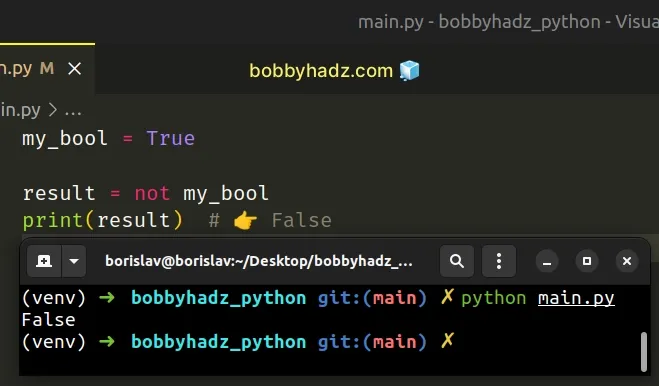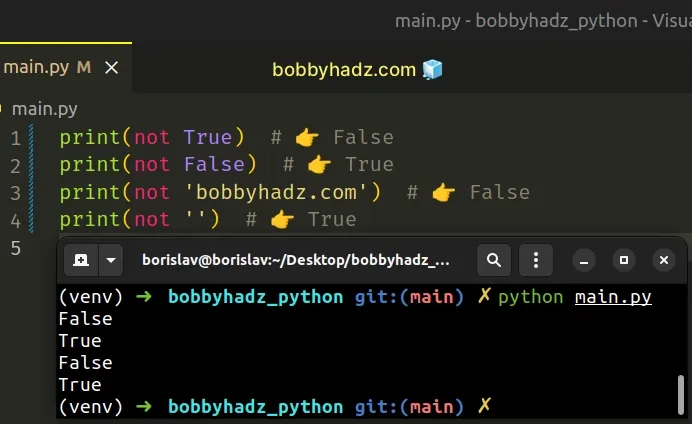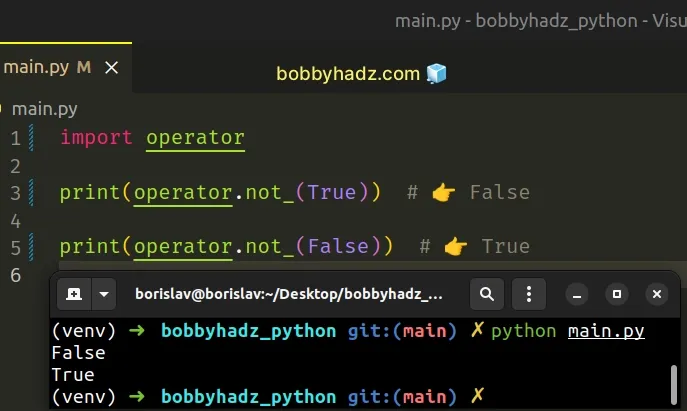Negate a boolean or a List of Booleans in Python
Last updated: Apr 9, 2024
Reading time·4 min

# Table of Contents
- Negate a boolean in Python
- Flip the boolean values in a List in Python
- Negate the boolean values in a NumPy array
# Negate a boolean in Python
Use the not operator to negate a boolean, e.g. result = not my_bool.
The not operator will negate the boolean value, returning True if the value
is False and False if the value is True.
my_bool = True result = not my_bool print(result) # 👉️ False

We used the not operator to negate a boolean value.
print(not True) # 👉️ False print(not False) # 👉️ True
The not operator returns True if the value is falsy and False if the value
is truthy.
print(not True) # 👉️ False print(not False) # 👉️ True print(not 'bobbyhadz.com') # 👉️ False print(not '') # 👉️ True

All values that are not truthy are considered falsy. The falsy values in Python are:
- constants defined to be falsy:
NoneandFalse. 0(zero) of any numeric type.- empty sequences and collections:
""(empty string),()(empty tuple),[](empty list),{}(empty dictionary),set()(empty set),range(0)(empty range).
# Negate a boolean using operator.not_
You can also use the operator.not_ method to negate a boolean.
import operator print(operator.not_(True)) # 👉️ False print(operator.not_(False)) # 👉️ True

The operator.not_ method negates the given object and returns the result.
The operator.not_ method is mostly used when you need to flip a list of
boolean values with map().
import operator list_of_booleans = [True, True, False, False] new_list = list(map(operator.not_, list_of_booleans)) print(new_list) # 👉️ [False, False, True, True]
# Don't use the bitwise NOT operator to negate booleans
Note that you shouldn't use the bitwise ~ not operator to negate boolean
values.
print(~True) # 👉️ -2 print(~False) # 👉️ -1
The bitwise ~ not operator returns unexpected results when used with boolean
values because booleans are a subclass of
int.
print(isinstance(True, int)) # 👉️ True
The operator doesn't return the negated boolean value, it returns the negated integer value.
# Flip the boolean values in a list in Python
To flip the boolean values in a list:
- Use a list comprehension to iterate over the list.
- Use the
notoperator to flip each boolean value. - The new list will contain the negation of the boolean values in the original list.
my_list = [True, True, False, False] new_list = [not item for item in my_list] print(new_list) # 👉️ [False, False, True, True]

We used a list comprehension to flip the boolean values in a list.
On each iteration, we use the not operator to flip the current boolean value
and return the result.
my_list = [True, True, False, False] new_list = [not item for item in my_list] print(new_list) # 👉️ [False, False, True, True]
The not operator returns True if the value is falsy and False if the value
is truthy.
print(not True) # 👉️ False print(not False) # 👉️ True print(not 'bobbyhadz.com') # 👉️ False print(not '') # 👉️ True
All values that are not truthy are considered falsy. The falsy values in Python are:
- constants defined to be falsy:
NoneandFalse. 0(zero) of any numeric type.- empty sequences and collections:
""(empty string),()(empty tuple),[](empty list),{}(empty dictionary),set()(empty set),range(0)(empty range).
Alternatively, you can use the map() function.
# Flip the boolean values in a list using map()
This is a three-step process:
- Pass a lambda function and the list to the
map()function. - The
map()function will call the lambda function with each boolean in the list. - Use the
list()class to convert themapobject to a list.
my_list = [True, True, False, False] new_list = list(map(lambda x: not x, my_list)) print(new_list) # 👉️ [False, False, True, True]
The map() function takes a function and an iterable as arguments and calls the function with each item of the iterable.
Lastly, we used the list() class to convert the map object to a list.
The list class takes an iterable and returns a list object.
# Negate the boolean values in a NumPy array
If you need to negate the boolean values in a NumPy Array, use the
numpy.logical_not() method.
import numpy as np arr = np.array([True, True, False, False], dtype=bool) result = np.logical_not(arr) print(result) # 👉️ [False False True True]
Make sure you have NumPy installed to be able to run the code sample.
pip install numpy # 👇️ or with pip3 pip3 install numpy
We used the numpy.logical_not method to negate a NumPy array.
The logical_not method applies the not operator to the elements of the
array.
The method returns a new array containing the negation of each element in the original array.
# Negate the boolean values in a NumPy array using bitwise NOT
The bitwise not ~ operator can be used to negate a NumPy array of booleans.
import numpy as np arr = np.array([True, True, False, False], dtype=bool) result = ~arr print(result) # 👉️ [False False True True]
You can also use the invert method to achieve the same result.
import numpy as np arr = np.array([True, True, False, False], dtype=bool) result = np.invert(arr) print(result) # 👉️ [False False True True]
The numpy.invert method computes bit-wise inversion, or bit-wise NOT, element-wise.
The method takes an array of booleans and inverts the values in the array.
There is also a bitwise_not method in NumPy.
import numpy as np arr = np.array([True, True, False, False], dtype=bool) result = np.bitwise_not(arr) print(result) # 👉️ [False False True True]
The bitwise_not method is an alias for invert.
# Additional Resources
You can learn more about the related topics by checking out the following tutorials:

